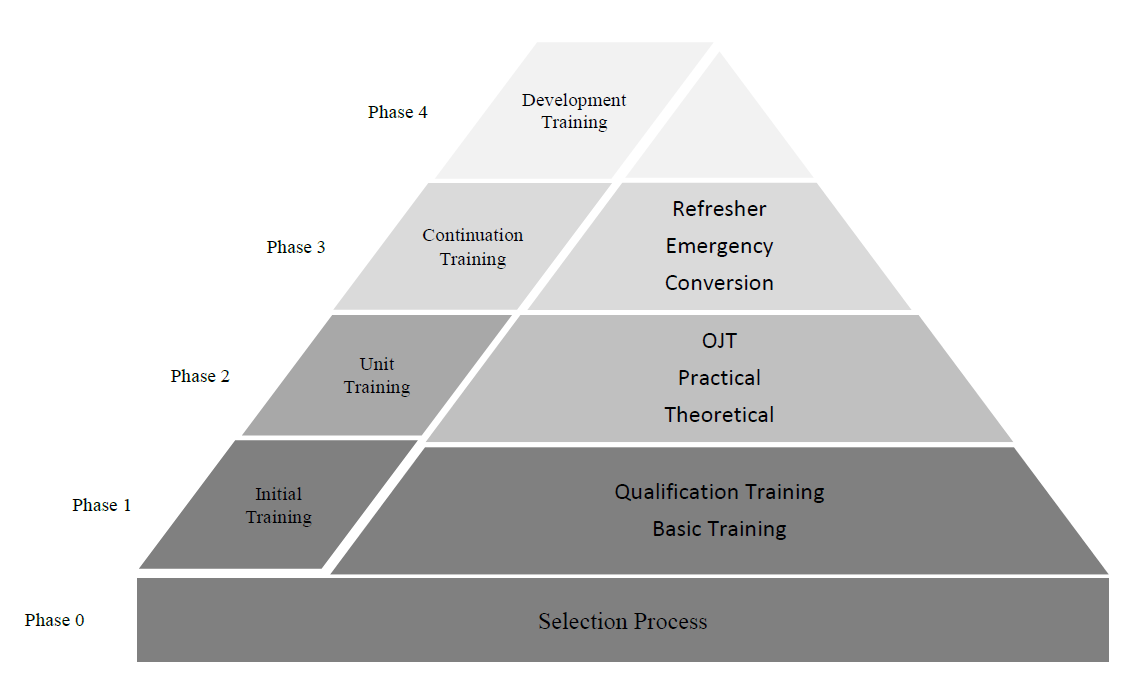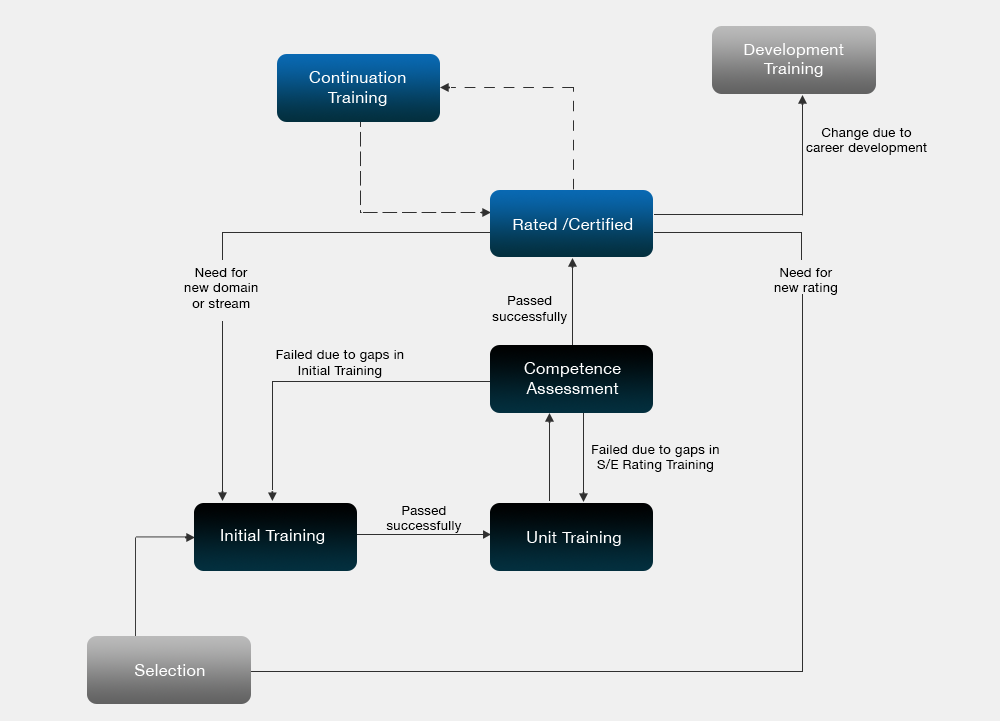Traditional teaching methods, including lectures and book study are an important part of ATSEP training. However, the most important part of ATSEP training is the use of training equipment that exposes students to situations they will or might encounter throughout their careers as ATSEP. The use of radar equipment and simulators are used throughout all phases of ATSEP training under both ICAO and EASA training requirements.
Training Equipment Used During the Basic Training Phase
During the ATSEP initial training phase, trainees go through a basic training sequence to acquire general knowledge about:
- International and national organizations and standards (e.g. ICAO, EASA, ECAC, IEEE)
- Air traffic services, airspace standards, meteorology, aeronautical information systems and altimetry
- CNS/ATM concepts
- Human factors
Included in this training phase are two subject streams that require the use of training equipment:
Subject #6 – Navigation (NAV)
Simulators are used to give trainees an understanding of:
- Instrument Landing Systems (ILS)
- Distance Measuring Equipment (DME)
- Very High Frequency Omni-Directional Range (VOR)
SkyRadar’s NavAids Simulator provides a set of standard equipment that is required under ICAO and EASA for normal and abnormal conditions. SkyRadar's aerodrome simulator applies NavAids and simulates their results in the frame of the tower simulation.
Subject #7 – Surveillance (SUR)
Training radars and simulators are used to introduce ATSEP trainees to primary and secondary radar surveillance concepts. Instructors can use them to teach radar principles and trainees to gain hands on experience with basic radar principles, calibrating primary radars, emergency situations if system failures occur, and the impact of changes in radar settings with visualization in the scopes.
SkyRadar’s PSR Radar can be used for:
- Operating Mode: Pulse
- Scopes (enabled through FreeScopes)
- A-Scope
- B-Scope
- Plan-Position-Indicator (PPI)
- Amplification
- Amplification of raw signal (IQ signal) at receiver
- Amplification of filtered signal in the scopes
- Filters and Signal Treatment
- Sensitivity Time Control (STC)
- Signal Threshold and Limiter
- Range Calibration and Extension
- Cutting out selections of the signal range
- Moving Target Detection and Indication
Surveillance simulators can be used for classroom training, including instructor presentations and for self-learning exercises during the basic training phase. Later, in the training process, these simulators can be used to familiarize trainees with emergency situations, including system failures and configuring surveillance equipment.
SkyRadar’s Surveillance Simulator includes simulations for:
- Operating modes, including Pulse CW, FMCW, SSR (Mode A/C & S)
- Scopes, including:
- A-Scope
- B-Scope
- Plan-Position-Indicator (PPI)
- Secondary radar, including:
- Pulse Diagrams and Table Sidelobe Suppression
- Uplink Format (UF)
- Downlink Format (DF)
- DBS registers
- Pseudo Pilot Screens
- Primary radars:
- Amplification of raw signal (IQ signal) at receiver
- Amplification of filtered signal in the scopes
- Sensitivity Time Control (STC)
- Signal Threshold and Limiter
- Range Calibration and Extension
- Moving Target Detection and Indication
- Cutting out selections of the signal range
The aerodrome simulator can be used to work on the complete radar signal conversion chain from sensors (the only part which is actually simulated), to Radar Data Processing Systems, Flight Data Processing, the complete visualization, voice and data communication etc. During initial training, the simulator can be used in a more holistic approach, providing the overview. Students will dive deeper into the system in later training phases.
After the basic training sequence, trainees continue in the qualification training sequence.
Training Equipment Used During Qualification Training
During the qualification training phase of ASTEP training, students must choose at least one of 16 qualification streams. These streams continue to build on trainees’ basic training to concentrate in specific areas, such as:
- Stream #1 – Communication – Voice
- Stream #2 – Communication – Data
- Stream #3 – Navigation – Non-Directional Beacon (NDB)
- Stream #4 – Navigation – Direction Finding (DF)
- Stream #5 – Navigation – VHF Omnidirectional Radio Range (VOR)
- Stream #6 – Navigation – Distance Measuring Equipment (DME)
- Stream #7 – Navigation – Instrument Landing System (ILS)
- Stream #8 – Navigation – Microwave Landing System (MLS)
- Stream #9 – Surveillance – Primary Surveillance Radar
- Stream #10 – Surveillance – Secondary Surveillance Radar
- Stream #11 – Surveillance – Automatic Dependent Surveillance
- Stream #12 – Data – Data Processing
- Stream #13 – System Monitoring and Control – Communication
- Stream #14 – System Monitoring and Control – Navigation
- Stream #15 – System Monitoring and Control – Surveillance
- Stream #16 – System Monitoring and Control – Data
Students can dive deep into all areas, as SkyRadar's ATC simulator consists of a real operating ATC infrastructure including all major systems such as RDPS, FDPS, APP, TWR, ACC infrastructure, the Voice and Data communication systems etc. Only the incoming radar sensors are simulated. Data communication is following standard protocols (e.g,, ASTERIX protocol).
Streams associated with Navigation topics require the use of simulators, such as SkyRadar’s NavAids Simulator for ILS, VOR, DME simulations.
Depending on the chosen Surveillance stream, various training radars and radar simulators are required during training, like SkyRadar’s PSR Radar, the PSR / SSR Surveillance Simulator, and the ADS-B Live Radar.
System Monitoring and Control Streams utilize various training equipment for simulations like those provided by SkyRadar’s NavAids Simulator, Multi-Modal Surveillance Radar and Aerodrome Simulator.
Training Equipment Used During Unit Training
The following overview graphic shows how the trainees are passed from the initial training phase (basic and qualification training) to the unit training phase.
On-the-job (OJT) is included in Unit Training to expose ATSEP to the job site’s specific operational environment. This requires training equipment that is capable of replicating that real-life environment, including tower simulators and radar equipment like SkyRadar’s Tower Simulators for ACC, APP, TWR and GRN simulations, Multi-Modal Radar and RASS-S Training Radar.
Training Equipment Used During Continuation Training
The infographic above show how trainees enter upon completion of the unit training the continuous "loop" of continuation training. A phase of continuous learning, evolution, freshups and skill updates, which makes sure that the ATSEPs are always up-to-date in their skill set. There are three categories of continuation training for ATSEP:
- Refresher training
- Emergency training
- Conversion training
This training may require that ATSEP learn new procedures, new equipment, how to handle emergency situations or receive a refresher course to review or reinforce their competencies. The equipment required for these trainings often needs to be specific to their work environment, especially if the training is not performed onsite. This includes simulators and radar training equipment, like SkyRadar’s Tower Simulators for ACC, APP, TWR and GRN simulations, SkyRadar’s Multi-Modal Radar which can be deployed in connection with the RASS-S Training Radar.
In particular the simulators can be used for training, accessed from the own workplace or home, to fresh up one's knowledge. The accompanying academies might embed them into a learning management system (e.g., Moodle) to make sure that training progress is guided, channeled and properly assessed.
References
- More articles on ATSEP training in accordance with ICAO 10057 (2018 - today), by Dawn M. Turner, Dennis Vasilev, Prof. Eric Moskwa, Dr. Ulrich Scholten and more
- More articles on Radar Training Systems (2018 - today), by Dennis Vasilev, Dr. Ulrich Scholten and more
- Manual on Air Traffic Safety Electronics Personnel, Competency-Based Training and Assessment DOC 10057 (2017), by ICAO






